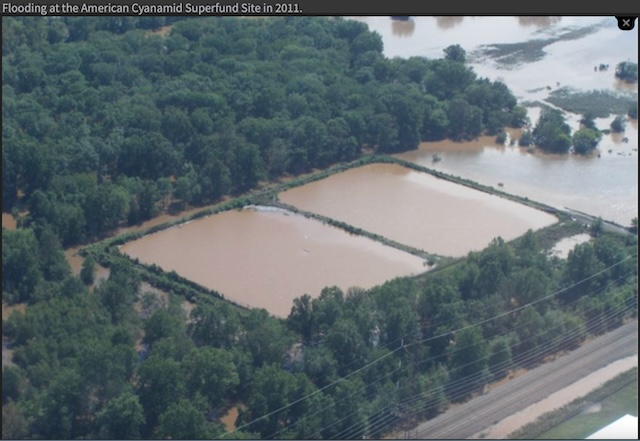Murphy DEP Dismisses Criticism Of American Cyanamid Superfund Natural Resource Damage Settlement
DEP Provides A Non Responsive Response To Public Comments
(Caption – Source: US EPA)
I just received DEP’s response to the comments I submitted on the proposed corporate sweetheart deal they cut with American Cyanamid at the Superfund site along the Raritan River (for comments, see:
The key criticism of the deal was the total lack of a factual basis to justify the deal:
“There is no document published by DEP that provides a science based assessment of natural resource damages or the economic value of these damaged resources or the nexus between the NRD damages and the restoration plan or how the public will be compensated fully for those damages.”
Ironically, the DEP response suffers exactly the same flaws as the Settlement itself: DEP spouts slogans and broad conclusions that are not supported by any science, facts, data, or other evidence.
DEP arrogantly dismissed my criticism with these broad and unsupported conclusions:
Thank you for your comments on the above-referenced proposed Consent Decree. After reviewing your comments, the Department has concluded that they did not present any information that would indicate that the proposed Consent Decree is inappropriate, improper, or inadequate. The commitments of Wyeth set forth in the proposed Consent Decree satisfactorily address the injury to, loss of, or damage to the floodplain, riparian, upland, and wetland natural resources of the American Cyanamid Superfund Site. Furthermore, the location of the Duke Farms Forested Floodplain Restoration Project, only 2.2 miles from the American Cyanamid Superfund Site, creates a strong ecological and economic nexus between the restoration work and the injury to natural resourcesand further supports the Department’s conclusion that the proposed Consent Decree is fair, reasonable, and consistent with the Spill Act.
I fail to understand how DEP can continue to get away with this.
The DEP claims that the restoration project is 2.2 miles from the site, and that location “creates a strong ecological and economic nexus between the restoration work and the injury to natural resources.”
But they fail to note the restoration location is UPRIVER from the Cyanamid Superfund site. Most of the off site damage from Cyanamid occurred DOWNRIVER, as contamination from the site flowed down river.
Could you imagine EPA letting Hudson River PCB polluter General Electric off the hook for a tiny restoration project (112 acre wetlands and $78,000) along the Hudson River in the Adirondacks?
No other program in DEP operates this way.
DEP is supposed to be a regulatory agency who makes science and law based decisions in a transparent and accountable fashion.
How can the Department negotiate and execute an agreement without identification and quantification of the ecological and economic damages?
Given that there are no DEP documents or even facts provided, how is the public to assess whether this agreement fully restores and fully compensates the public for NR injuries?
How can a court determine whether it is in the public interest?
I fail to understand how DEP can implement such an important environmental program in the absence of science, economics, and transparency.
